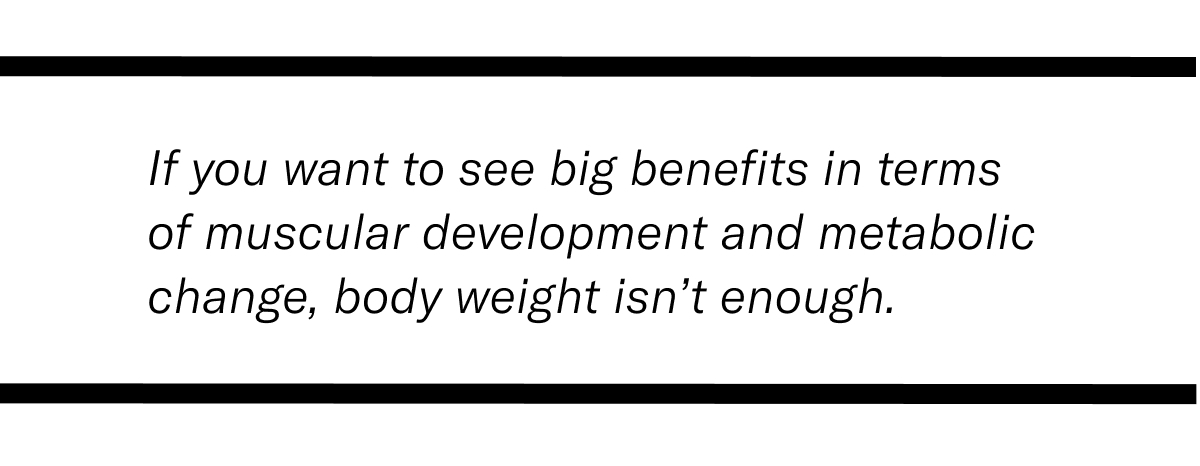Both calisthenics and lifting weights can help you make gains, but one is a more efficient method than the other.
There’s no arguing that any form of strength training offers a host of benefits that include fat burning and weight management, healthy aging, and improved mental and emotional health. But how you strength train makes a difference in how fast and effectively you meet your goals.
For some, calisthenics, or working against just body weight, can be enough stress to stimulate some muscle growth. Doing push-ups, for example, can be as effective as bench-pressing for increasing upper-body strength and muscle density, according to a 2015 study in the Journal of Strength and Conditioning Research. This form of training, however, has its limitations.
“Bodyweight training works against the downward pull of gravity,” says Alex Rothstein, a certified personal trainer and coordinator for New York Institute of Technology’s Exercise Science program. “That means to work any specific muscle group, an individual has to position or angle their body appropriately to work against the downward force.”
Picture that push-up: As you slowly lower to the ground, you’re resisting the pull of gravity; as you push back up, you’re pushing against the pull of gravity. With bodyweight exercise, you can adjust variables to make exercises harder (or easier), but “past a certain point, bodyweight resistance produces more of an endurance exercise than a strength or muscle-building one,” says Jack McNamara, an exercise physiologist and certified strength and conditioning specialist with TRAINFITNESS. Translation: If you want to see big benefits in terms of muscular development and metabolic change, body weight isn’t enough.

“Muscles grow bigger when we overload them with progressively higher levels of resistance or weight,” explains McNamara. “That process creates tiny tears of the muscle fibers themselves, and during recovery, these fibers repair to become bigger and stronger.” Progressive overload is crucial to developing strength, but how it’s accomplished can depend on various training factors, such as load, training volume, tempo, and time under tension, he adds.
“Because you can’t easily change the weight of a person and can only change the positioning of an exercise, it can be hard to progress calisthenics training as you get stronger,” says Rothstein. Without added resistance, you’ll eventually plateau.
Bands, cables, and digital weight allow people to set and adjust resistance and work outside the force of gravity, says Rothstein. With bands, for example, the further you pull the more the resistance will increase. Cable resistance depends on your momentum (the slower you pull or release, the harder or easier it feels). And the advantage of Tonal’s adaptive digital weight is the resistance can adjust to every individual in real-time to be more or less challenging.
“Added resistance is a great way to stimulate adaptation beyond the requirements of normal daily tasks,” says Rothstein. “For example, squatting with weight makes sitting and standing feel significantly easier because you built the strength to perform a loaded stand-up and are performing it with only bodyweight.” Think about how many different variations you’d need to try to progress that push-up. Progressing a bench press, on the other hand, could be as simple as adding more weight to the bar—which would make adhering to the principle of progressive overload way easier.
“External loading also allows us to target or isolate specific muscle groups that prove far more challenging using bodyweight alone,” says McNamara. “Depending on the nature of the loading, one primary muscle or muscle group can be made to work against all of the resistance, which can help fast-track recovery from injury or work on stubborn imbalances that are hampering progress.”
Weight training allows both progressive overload and muscle or muscle group isolation, which means your workouts become more efficient. That’s the difference between spending hours cranking out push-ups and bodyweight squats and fitting a fast-but-challenging 20-minute workout into your schedule. Pair that with features on Tonal that make workouts even more effective like dynamic weight modes, form feedback, progress tracking, and coach-led programming, and it’s easy to see how one method is far more effective than the other.
That doesn’t mean you should never do bodyweight exercises—outside of developing strength, the benefits of this type of training include improved stability, flexibility, and coordination. Plus, bodyweight training offers the opportunity to perfect your form before adding load, but external resistance gives you more versatility and longer-term opportunities if making serious gains is your goal.
“Most of us start our exercise journey with bodyweight training one way or another,” says McNamara. “As our coordination, stability, and motor control improve, we generally evolve our approach to training to add in external stimuli to achieve progressive overload more efficiently.”
Once you’ve got your form dialed in during bodyweight exercise, add weights and progress slowly. “People like to add weight very quickly,” says Rothstein, which can lead to overtraining or injury. But Tonal’s artificial intelligence provides weight recommendations based on where you are and increases the resistance in one-pound increments as you get stronger.
In the end, both forms of strength training will improve your body composition and health, but resistance training with load like the digital weight provided by Tonal is a far more effective and efficient way to achieve your goals.
